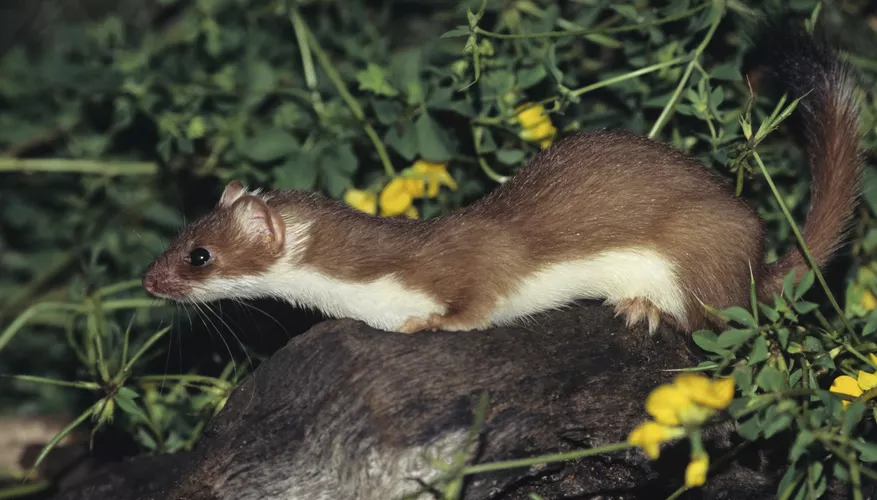Weasels belong to the genus Mustela, a group of small carnivorous mammals known for their long, slender bodies and highly efficient hunting abilities. The Mustela genus includes about 17 species, such as true weasels, stoats, polecats, black-footed ferrets, and European mink. These animals primarily prey on small rodents, making them highly beneficial for farmers and gardeners.

| Weasel Type | Scientific Name | Size | Geographical Range | Notable Features | Conservation Status |
|---|---|---|---|---|---|
| Least Weasel | Mustela nivalis | Up to 8 inches (20 cm) | North America, Europe, Asia | Smallest carnivore in the world | Least Concern |
| Long-Tailed Weasel | Mustela frenata | Up to 18 inches (46 cm) | North & Central America | Long tail, highly adaptable | Least Concern |
| Stoat (Ermine) | Mustela erminea | Up to 13 inches (33 cm) | North America, Europe, Asia | Turns white in winter | Least Concern |
| European Polecat | Mustela putorius | Up to 20 inches (50 cm) | Europe | Ancestor of the domestic ferret | Least Concern |
| Steppe Polecat | Mustela eversmanii | Up to 20 inches (50 cm) | Eastern Europe, Central Asia | Robust, burrowing lifestyle | Least Concern |
| Black-Footed Ferret | Mustela nigripes | Up to 24 inches (61 cm) | North America (endemic) | Critically endangered, nocturnal hunter | Endangered |
| European Mink | Mustela lutreola | Up to 16 inches (41 cm) | Europe (France, Spain, Russia, Ukraine, Romania) | Critically endangered, similar to American mink | Critically Endangered |
Weasels are widely distributed across Asia, Europe, and the Americas, though they are absent from Oceania and most of Africa, except where ferrets have been introduced.
Long-Tailed Weasel (Mustela frenata): One of the most widespread species, known for its adaptability and long tail.
Least Weasel (Mustela nivalis): The smallest carnivore in the world, reaching only 8 inches (20 cm) in length and weighing up to 4.5 ounces (128 g).
Both species are excellent hunters that control rodent populations in forests, grasslands, and even farmlands.
The stoat (Mustela erminea), also called ermine, is native to North America, Asia, and Europe but has become a major pest in New Zealand, where it was introduced.
Its coat turns pure white in winter, making its fur highly valuable in the fur trade.
Unlike many other fur-bearing mammals, stoats are not endangered, as they thrive in various climates.
They are fierce hunters, often taking on prey larger than themselves.
Polecats are larger Mustela species with a robust build.
| Species | Scientific Name | Notable Traits |
|---|---|---|
| European Polecat | Mustela putorius | Ancestor of domestic ferrets, dark fur, widespread in Europe |
| Steppe Polecat | Mustela eversmanii | Lives in burrows, found in Eastern Europe and Central Asia |
The European polecat has a significant historical role as it gave rise to the domestic ferret, which is now widely kept as a pet and used for hunting rodents.
The black-footed ferret (Mustela nigripes) is North America’s only native ferret species.
Once declared extinct in the wild (1987), intensive conservation efforts have helped reintroduce small populations.
It remains one of the most endangered carnivores, with only about 250 individuals in the wild.
Black-footed ferrets are strict nocturnal hunters, primarily preying on prairie dogs.
Habitat destruction due to prairie dog population decline.
Disease outbreaks affecting their limited population.
Conservation programs have helped stabilize numbers, but the species remains fragile.
The European mink (Mustela lutreola) looks similar to the American mink but is not closely related.
Found in France, Spain, Russia, Ukraine, and Romania, though once widespread.
Critically endangered due to overhunting, habitat loss, and competition from the invasive American mink.
Unlike the semi-aquatic American mink, the European mink prefers riverbanks and wetland environments.
Fur trade over-exploitation in the past led to severe population declines.
Habitat destruction and human encroachment.
Competition from the invasive American mink, which is more aggressive and adaptable.
The Mustela genus includes a wide variety of species, from tiny least weasels to large polecats and endangered ferrets.
Weasels are highly skilled hunters, known for their long, slender bodies and rodent-hunting abilities.
Stoats change color in winter, making them valuable in the fur trade.
Polecats are the wild ancestors of domestic ferrets.
Black-footed ferrets and European mink face critical threats, requiring conservation efforts.
By understanding these fascinating carnivores, we can better appreciate their ecological role and the importance of conservation for endangered species.
animal tags: weasels
We created this article in conjunction with AI technology, then made sure it was fact-checked and edited by a Animals Top editor.